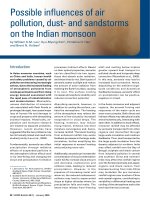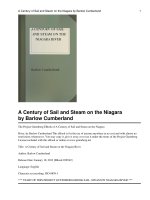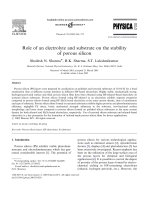Evaluation of effect of blend of limestone and gypsum on the compressive strength of portland blended cement
Bạn đang xem bản rút gọn của tài liệu. Xem và tải ngay bản đầy đủ của tài liệu tại đây (626.24 KB, 6 trang )
Vietnam Journal of Science and Technology 57 (3A) (2019) 128-133
doi:10.15625/2525-2518/57/3A/13936
EVALUATION OF EFFECT OF BLEND OF LIMESTONE AND
GYPSUM ON THE COMPRESSIVE STRENGTH OF PORTLAND
BLENDED CEMENT
Ta Ngoc Dung1, *, Hoang Canh Nguyen1, Pham Thanh Mai2
1
School of Chemical Engineering, Hanoi University of Science and Technology,
01 Dai Co Viet, Ha Noi
2
Hanoi Architectural University, km 10 Nguyen Trai Road, Ha Noi
*
Email:
Received: 12 July 2019; Accepted for publication: 29 September 2019
Abstract. Limestone and gypsum all affect the strength of hardened cement paste. However, for
practical application in each plant, the interaction of each specific mixture of limestone and
gypsum to the strength of each specific cement still needs to be further verified. This paper will
focus on clarifying the mechanism of simultaneous impact of gypsum and limestone additives on
compressive strength of cement.
The experimental results show that the addition of the combination of limestone and
gypsum improves the compressive strength of cement when using limestone or gypsum
separately. Cement samples use only 5 wt% gypsum or 5 wt% limestone as additives, with a
compressive strength after 1 day reduced from 15 % to 80 % compared with cement samples
using a mixture of 5 wt% gypsum and 5 wt% limestone as additives. This can be explained by
the role of limestone in stabilizing of ettringite, preventing phase transformation from the AFt
phase to the AFm phase.
Keywords: gypsum, limestone, blend, strength, PCB cement.
Classification numbers: 2.9.2, 2.9.4.
1. INTRODUCTION
Limestone and gypsum are two common additives in Portland cement blended (PCB).
There have been many studies [1-7] on the effect of each of these additives on propreties of
cement. However, in each specific case, the effect of combination of them has been still needing
additional research.
The addition of gypsum has been used to control the setting time, and improving cement
strength, especially early strength of cement [1, 2]. Besides, limestone has been known as a filler
additive, also known as inert additive, which is mixed into cement with the purpose of increasing
the capacity of cement production, and result in lowering product costs. In addition, when
mixing inert additive in cement, it is necessary to pay attention to the proportion to ensure the
quality of the product [1, 3].
Evaluation of effect of blend of limestone and gypsum on the compressive strength …
In fact, some studies [4-7] show that limestone is not just a filler additive. It also
participates in the hydration process, creating products similar to that of gypsum, contributing to
improving the early strength of hardened cement paste.
This paper focuses on the interaction effect between limestone and gypsum on compressive
strength of cement. The experimental results from this research reveal great practical
implications for the Portland cement blended, in which it provides more useful information and
references for the study of synergistic effects of gypsum and limestone additives on the
development of strength of Portland cement blended.
2. MATERIALS AND RESEARCH METHODS
2.1. Materials
The materials used in the study include: FiCO Tay Ninh clinker (meet the requirements of
Vietnamese standard TCVN 7024: 2013), Sroc Con Tran Tay Ninh limestone, Thailand gypsum
(comply with the TCVN 9807: 2013).
The chemical and mineral composition of FiCO Tay Ninh clinker (determined according to
TCVN 141:2008 and TCVN 7024:2013) is shown in Table 1. The chemical composition of Sroc
Con Tran Tay Ninh limestone (determined according to TCVN 9191:2012) is shown in Table 2.
The chemical composition of gypsum (determined according to TCVN 9807:2013) is shown in
Table 3.
Table 1. Mineral and chemical composition of Fico Tay Ninh clinker.
SiO2
21.04
C3S
58.92
Al2O3
5.62
C2S
16.19
Fe2O3
3.60
C3A
8.81
MgO
3.76
C4AF
10.94
CaO
64.31
Table 2. Chemical composition of Sroc Con Tran Tay Ninh limestone.
LOI
40.38
SiO2
4.82
Al2O3
1.29
Fe2O3
0.37
CaO
49.95
MgO
2.44
Fe2O3
0.50
CaO
32.23
Table 3. Chemical composition of gypsum.
LOI
20.71
SO3
45.63
SiO2
0.88
Al2O3
0.00
2.2. Preparation of cement samples
Clinker, limestone and gypsum was crushed to a particle size smaller than 5 mm. Then,
each material was ground separately in a test ball mill with the same grinding time of 65
minutes. Clinker powder, limestone powder and gypsum powder were mixed in proportion to the
ingredients (Table 4) to create samples M22, T22, D22 and TD22.
2.3. Test methods
Normal consistency and setting time of cement were determined according to TCVN 6017:
2015. The fineness of cement was determined according to TCVN 4030: 2003. The strength of
cement was determined according to TCVN 6016: 2011. Scanning electron microscopy (SEM)
129
Ta Ngoc Dung, Hoang Canh Nguyen, Pham Thanh Mai
images were used to detect specific forms of minerals, microstructures, and crystals of hardened
cement paste.
Table 4. Proportions of clinker, limestone and gypsum powders in this study.
Sample
M22
T22
D22
TD22
Clinker, wt%
100
95
95
90
Gypsum, wt%
0
5
0
5
Limestone, wt%
0
0
5
5
3. RESULTS AND DISCUSSION
3.1. The fineness of samples using gypsum and limestone additives
Clinker, limestone and gypsum were separately crushed, then mixed in different
proportions, mixing ratio and fineness are given in Table 5.
Table 5. The Blaine fineness and residual fineness of R0.045, R0.09 sieve of cement samples.
Sample
M22
D22
T22
TD22
Clinker,
wt%
100
95
95
90
Gypsum,
wt%
0
0
5
5
Limestone,
wt%
0
5
0
5
Blaine,
cm2/g
4286
4391
4141
4747
Residual
R0.045, %
12.74
11.23
13.53
13.83
Residual
R0.09, %
1.39
1.01
2.89
3.32
In which: R0.09 sieve has mesh sizes of 90 m and R0.045 sieve has a mesh sizes of 45 m.
Although with the same grinding time, but the grinding ability of clinker, limestone,
gypsum varies, so the fineness of different mixes is also different.
3.2. Compressive strength of samples using gypsum and limestone additives
The individual effects of gypsum and limestone additives, as well as the effects of
simultaneous use of limestone and gypsum additives on the compressive strength of hardened
cement paste are given in Table 6.
Table 6. The compressive strength of cement samples mixed with gypsum and limestone additives.
Sample
Grinding
time, min
Blaine fineness of
blended cement, cm2/g
M22
D22
T22
TD22
65
65
65
65
4286
4391
4141
4747
130
Compressive strength, MPa
1 day
11.7
13.9
21.8
25.1
3 days
23.4
27.8
35.2
36.4
7 days
31.6
33.7
48.9
46.0
28 days
45.3
40.6
55.1
54.2
Compressive strength, %
M22
D22
T22
TD22
180%
130%
80%
1 day 3 days 7 days
28
days
Compressive strength, MPa
Evaluation of effect of blend of limestone and gypsum on the compressive strength …
Time, days
60
50
40
30
20
10
1 day
3 days
7 days 28 days
Time, days
M22
D22
T22
TD22
Figure 1. Compressive strength of hardened cement paste at 1, 3, 7, 28 days.
From Table 6 and Figure 1, it can be seen that:
When replacing 5 wt% of clinker by limestone, compressive strength of samples at 1, 3 and
7 days is improved, however, the compressive strength at 28 days is reduced incomparable with
that of M22 sample. This result is not different from other research results [3-7]. Besides, when
replacing 5 wt% of clinker with gypsum, compressive strength is improved at all days. This
result is consistent with other studies [1,2].
Moreover, when replacing 10 wt% of clinker with 5 wt% of limestone and 5 wt% of
gypsum, although the amount of clinker decreases, the strength of this blended cement sample is
still improved in comparable with that of T22 and D22 samples.
It can be seen that the rate of increase in compressive strength decreases with time. The
earlier the age is, the higher compressive strength increase. The addition of gypsum additives
affects compressive strength more significantly than that of limestone additives. The
simultaneous use of limestone and gypsum improves the compressive strength better than
separate use.
Specifically, when using limestone (D22), gypsum (T22) and the combination of gypsum
and limestone (TD22), the compressive strength after 1 day increases by 20%, over 85%, and
over 110% compared with that of the original M22 cement sample, respectively. However, the
increasing rate of compressive strength up to 28 days is decreased, the increase is only -10% for
the D22 sample and about 20% for the T22 and TD22 samples.
3.3. Microstructure analysis of samples using gypsum and limestone additives
Scanning electron microscopy images are used to detect specific forms of minerals,
microstructures, and crystals. SEM images of hardened cement paste samples, i.e. M22, D22,
T22, TD22, are shown in Figure 2.
131
Ta Ngoc Dung, Hoang Canh Nguyen, Pham Thanh Mai
Ca(OH)2
Ettringite
Ettringite
Ca(OH)2
Ca(OH)2
Ca(OH)2
Ettringite
Fiber
structure
Ca(OH)2
Ettringite
Fiber
structure
Ettringite
Figure 2. SEM images of M22, D22, T22, TD22 samples.
It can be observed from figure 2 that:
The Ca(OH)2 hydration product mainly appears in the sample M22. With samples D22 and
T22, there appear more intertwined fiber or needle structures in pores. This may be the product
of C3A.3CaCO3.(31-32)H2O in sample D22, or the product of C3A.3CaSO4.31H2O (ettringite) in
the T22 sample. Fibrous and needle-like structures interwoven in pores and increased bonding
capacity contribute to increase compressive strength.
Moreover, ettringite crystals can be observed more clearly in the sample TD22 , but not
found in samples using only limestone (D22) or only gypsum (T22). According to previous
studies [1], the ettringite (AFt) phase over time will gradually shift to monosulfoaluminate
(AFm) phase. At the same hydration time, the ettringite phase in the T22 and TD22 samples is
significantly different. This indicates a mutual impact when adding the combination of limestone
and gypsum. The addition of limestone will contribute to increase the stability of ettringite,
preventing phase transformation from the AFt phase to the AFm phase. This is the main reason
for the improved compressive strength of TD22 sample in comparable with that of the T22 and
D22 samples, especially at early ages as the ettringite product plays an important role in the
strengthening the microstructure of cement paste, and resulting in ỉmproving compressive
strength of samples.
132
Evaluation of effect of blend of limestone and gypsum on the compressive strength …
The results of the SEM image analysis (the addition of limestone will contribute to increase
the stability of ettringite, preventing phase transformation from the AFt phase to the AFm phase)
are completely consistent with the results of compressive strength in section 3.2.
4. CONCLUSIONS
Based on the experimental results of this study, the following conclusions can be drawn:
- The addition of limestone and gypsum additives all increases the compressive strength of
hardened cement paste.
- The strength of blended cement increases with time. The earlier the age is, the higher the
compressive strength increase. When using limestone (D22), gypsum (T22) and gypsum
limestone (TD22), the compressive strength after 1 day is increased by 20 %, over 85 %, and
over 110 % compared with that of the original M22 cement sample, respectively. However, the
rate of increasing in compressive strength up to 28 days is decreased, the increase is only -10 %
for the D22 sample and about 20 % for T22 and TD22 samples.
- The addition of gypsum additives influences on compressive strength of blended cement
more significantly than that of limestone additives. The simultaneous use of limestone and
gypsum improves compressive strength higher than it is used seperately.
Acknowledgements. This research is funded by Hanoi University of Science and Technology (HUST)
under grant number T2017-HTDN-03.
REFERENCES
1.
Taylor H. F. W. - Cement Chemistry, Academic Press Ltd., London (1990).
2.
Hassaan M. Y. - Effect of gypsum on the strength development of Portland cement by
Mössbauer spectrometry, Hyperfine Interactions 42(1-4) (1988) 1199-1202.
3.
Vuk T., Tinta V., Gabrovšek R., Kaučič V. - The effects of limestone addition, clinker
type and fineness on properties of Portland cement, Cement and Concrete Research 31
(2001) 135-139.
4.
Nehdi M., Mindess S., Aϊtcin P. C. - Optimization of high strength limestone filler cement
mortars, Cement and Concrete Research 26 (6) (1996) 883-893.
5.
Pera J., Husson S., Guilhot B. - Influence of finely ground limestone on cement hydration,
Cement and Concrete Composites 21 (2) (1999) 99-105.
6.
Kakali G., Tsivilis S., Aggeli E., Bati M. - Hydration products of C3A, C3S and Portland
cement in the presence of CaCO3, Cement and concrete research 30 (2000) 1073-1077.
7.
Livesey P. - Strength characteristics of Portland-limestone cements, Construction and
building materials 5 (3) (1991) 147-150.
133









